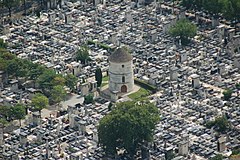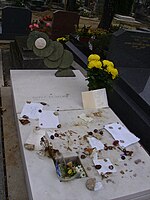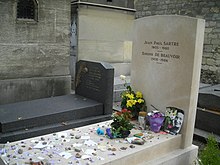Montparnasse Cemetery: Difference between revisions
Removing "Tumba_PD.jpg", it has been deleted from Commons by Green Giant because: Unfree Flickr license: https://flickr.com/photos/35335781@N00/127858605 is licensed under All Rights Reserved. |
Minor correction regarding Castoriades' Nationality and Citizenship |
||
| Line 105: | Line 105: | ||
* [[Rene Cassin]] (1887–1976), jurist, Nobel Laureate. His remains were later transferred to the [[Pantheon (Paris)|Panthéon]]. |
* [[Rene Cassin]] (1887–1976), jurist, Nobel Laureate. His remains were later transferred to the [[Pantheon (Paris)|Panthéon]]. |
||
* [[Sergio de Castro (artist)]] (1922-2012), Argentinian painter, musician and poet |
* [[Sergio de Castro (artist)]] (1922-2012), Argentinian painter, musician and poet |
||
* [[Cornelius Castoriadis]] (1922-1997), |
* [[Cornelius Castoriadis]] (1922-1997), [[Greeks|Greek]] philosopher with French citizenship |
||
* [[Aristide Cavaillé-Coll]] (1811–1899), [[organ builder]] |
* [[Aristide Cavaillé-Coll]] (1811–1899), [[organ builder]] |
||
* [[Emmanuel Chabrier]] (1841–1894), composer |
* [[Emmanuel Chabrier]] (1841–1894), composer |
||
Revision as of 17:50, 24 November 2015
| Montparnasse Cemetery | |
|---|---|
 Montparnasse Cemetery | |
 | |
| Details | |
| Established | 1824 |
| Location | |
| Country | France |
| Type | Non-denominational |
| Owned by | Mairie de Paris |
| Size | 19 hectares (47 acres) |
| No. of graves | 35,000 |
| Website | Montparnasse Cemetery |
| Find a Grave | 639007 |

Montparnasse Cemetery (French: Cimetière du Montparnasse) is a cemetery in the Montparnasse quarter of Paris, part of the city's 14th arrondissement.
History
Created from three farms in 1824, the cemetery at Montparnasse was originally known as Le Cimetière du Sud (Southern Cemetery). Cemeteries had been banned from Paris since the closure, owing to health concerns, of the Cimetière des Innocents in 1786. Several new cemeteries outside the precincts of the capital replaced all the internal Parisian ones in the early 19th century: Montmartre Cemetery in the north, Père Lachaise Cemetery in the east, and Montparnasse Cemetery in the south. At the heart of the city, and today sitting in the shadow of the Eiffel Tower, is Passy Cemetery.
Notes
Montparnasse Cemetery is the eternal home of many of France's intellectual and artistic elite as well as publishers and others who promoted the works of authors and artists. There are also many graves of foreigners who have made France their home, as well as monuments to police and firefighters killed in the line of duty in the city of Paris.
The cemetery is divided by Rue Émile Richard. The small section is usually referred to as the small cemetery (petit cimetière) and the large section as the big cemetery (grand cimetière).
Although Baudelaire is buried in this cemetery (division 6), there is also a cenotaph to him (between division 26 and 27).
Because of the many notable people buried there, it is a highly popular tourist attraction.
Divisions 5 and 30 were originally Jewish enclosures and contain many Jewish graves.
Notable interments
Among those interred here are:
A
- Henri Alekan (1909–2001), cinematographer
- Alexander Alekhine (1892–1946), Russian-born chess world champion
- Grace Alekhine (1876–1956), artist and chess master
- Michèle Arnaud (1919–1998), singer
- Raymond Aron (1905–1983), philosopher, sociologist and political scientist
- Jean-Michel Atlan (1913–1960), poet and painter
- Tina Aumont (1946–2006), actress, daughter of Jean-Pierre Aumont and Maria Montez
- Georges Auric (1899–1983), composer, member of Les Six
B


- Shapour Bakhtiar (1914–1991), last prime minister of the constitutional monarchy in Iran
- César Baldaccini (1921–1988), sculptor
- Théodore de Banville (1823–1891), poet, writer
- Frédéric Bartholdi (1834–1904), sculptor of the Statue of Liberty
- Maryse Bastié (1898–1952), pioneer aviatrix
- Pierre Batcheff (1901–1932), actor
- Jane Bathori (1877–1970), opera singer
- Charles Baudelaire (1821–1867), poet
- Jean Baudrillard (1929–2007), French cultural theorist, philosopher, political commentator, and photographer
- Simone de Beauvoir (1908–1986), feminist philosopher & author
- Jacques Becker (1906–1960), filmmaker
- Samuel Beckett (1906–1989), Irish author, playwright & poet
- Eugène Belgrand (1810–1878), civil engineer
- Paul Belmondo (1898–1982), French sculptor
- Jean Béraud (1849–1935), painter
- Emmanuel Berl (1892–1976), writer
- Aloysius Bertrand (1807–1841), poet
- Marcel Alexandre Bertrand (1847–1907), geologist, founder of the plate tectonic theory
- Louis Gustave Binger (1856–1936), explorer
- Lucien Bodard (1914–1998), journalist
- Marc Boegner (1881–1970), theologist and academician
- Jean-Marie Bonnassieux (1810–1892), sculptor
- Aristide Boucicaut (1810–1877), entrepreneur and creator of Le Bon Marché chain of department stores
- William-Adolphe Bouguereau (1825–1905), artist (painter in realist style)
- Antoine Jacques Claude Joseph, comte Boulay de la Meurthe (1761–1840), statesman
- Antoine Bourdelle (1861–1921), sculptor & teacher
- Paul Bourget (1852–1935), writer
- Marcel Bozzuffi (1928–1988), actor
- Gérard Brach (1927–2006), screenwriter
- Constantin Brâncuși (1876–1957), Romanian sculptor
- Brassaï (born Gyula Halász) (1899–1984), photographer
- Charles-Édouard Brown-Séquard (1817–1894), physician
- Jean Bruller (1902–1991), author who wrote under the nom de plume of Vercors
C

- René Capitant (1901–1970), lawyer and statesman
- Roger Caillois (1913–1978), author
- Jean Carmet (1920–1994), actor
- Isabelle Caro (1982-2010), model
- Eugène Carrière (1849–1906), Symbolist painter
- Rene Cassin (1887–1976), jurist, Nobel Laureate. His remains were later transferred to the Panthéon.
- Sergio de Castro (artist) (1922-2012), Argentinian painter, musician and poet
- Cornelius Castoriadis (1922-1997), Greek philosopher with French citizenship
- Aristide Cavaillé-Coll (1811–1899), organ builder
- Emmanuel Chabrier (1841–1894), composer
- Honoré Champion (1846–1913), publisher
- Claude François Chauveau-Lagarde (1756-1841), lawyer, defender of Marie-Antoinette
- Marie-Dominique Chenu (1895-1990), Catholic theologian
- Emil Cioran (1911–1995), Romanian philosopher
- André Citroën (1878–1935), founded France's Citroën automobile factory
- Antoni Clavé (1913–2005), artist
- Yves Congar (1904–1995), Catholic theologian
- François Coppée (1842–1908), poet and novelist
- Gaspard-Gustave Coriolis (1792–1843), mathematician
- Julio Cortázar (1914–1984), Argentinian author
- Antoine Augustin Cournot (1801–1877), economist
- Maurice Couve de Murville (1907–1999), former Prime Minister of France
- Adolphe Crémieux (1796–1880), lawyer and statesman
- Charles Cros (1842–1888), poet and inventor
D
- Jules Dalou (1838–1902), sculptor
- Gabriel Davioud (1824–1881), architect
- Pierre David-Weill (1900–1975), banker, Chairman of Lazard Frères
- Suzanne Dechevaux-Dumesnil (1900–1989), lover and, later, wife of Samuel Beckett
- Jacques Demy (1931–1990), film director
- Édouard Deperthes (1833–1898), architect
- Paul Deschanel (1855–1922), former President of France
- Robert Desnos (1900–1945), Surrealist poet
- Porfirio Díaz (1830–1915), longest serving Mexican President, Dictator, General
- Marie Dorval (1798–1849), actress
- Alfred Dreyfus (1859–1935), Jewish military officer falsely accused of treason (the Dreyfus affair)
- Jules Dumont d'Urville (1790–1842), explorer of South Pacific & discoverer of Venus de Milo
- Marguerite Duras (1914–1996), author & movie director
- Émile Durkheim (1858–1917), sociologist
- Henri Dutilleux (1916-2013), composer
E
- Émile Egger (1813–1885), philologist
- Robert Enrico (1931–2001), film director
- Antoine Étex (1808–1888), sculptor
F
- Henri Fantin-Latour (1836–1904), artist
- Léon-Paul Fargue (1876–1947), poet and essayist
- Henri Flammarion (1846–1936), publisher
- Paul Foucher (1810–1875), dramatist and journalist
- César Franck (1822–1890), composer & organist
- Othon Friesz (1879–1949), painter
- Carlos Fuentes (1928–2012), writer
G
- Serge Gainsbourg (1928-1991), singer and composer
- Évariste Galois (1811-1832), mathematician and revolutionary
- Charles Garnier (1825–1898), designed the original Paris Opera House for Napoleon III
- Henry Gauthier-Villars (1859–1931), writer and first husband of Colette
- François Gérard (1770–1837), artist
- Jean Giraud (1938-2012), illustrator, comic artist, also known as Moebius
- Alexandre Guilmant (1837–1911), organist and composer
- Mavis Gallant (1922-2014), author
H
- Jean Nicolas Pierre Hachette (1769–1834), mathematician
- Clara Haskil (1895–1960), Romanian pianist
- Swan Hennessy (1866–1929), Irish-American composer, and his son Patrice Hennessy (1910–1973), French man of letters
- Pierre-Jules Hetzel (1814–1886), publisher and literary editor
- Jean-Antoine Houdon (1741–1828), famous sculptor of notable men
- Joris-Karl Huysmans (1848–1907), author
I
- Roger Ibáñez (1931–2005), actor
- Vincent d'Indy (1851–1931), composer
- Eugène Ionesco (1909–1994), Romanian playwright
- Jean Robert Ipousteguy (1920–2006), sculptor, painter
- Joris Ivens (1898–1989), Dutch filmmaker
J
- Jean Bernard Jauréguiberry (1815–1887), admiral and statesman
- Joëlle (1953–1982), American-born French singer
- Gustave Jundt (1830–1884), painter
- Jean Giraud (1938-2012), artist, cartoonist, and writer
- Geneviève Joy (1919-2009), French classical and modernist pianist
K
- Gustave Kahn, (1859-1936), poet and art critic
- Joseph Kessel (1898–1979), writer
- Kiki (1901–1953), singer, actress, painter, "Queen of Montparnasse" (although she was probably buried in Thiais)
- Adamantios Korais (1748–1833), Greek writer and philosopher
L

- Bernard Lacoste (1931–2006), president of Lacoste apparel company
- Jean-Baptiste Lamarck (1744-1829), naturalist and zoologist (unearthed in 1834, lost body)
- Henri Langlois (1914–1977), film preservationist
- Pierre Larousse (1817–1875), author of encyclopedia Larousse Gastronomique
- Henri Laurens (1885–1954), sculptor, engraver
- Alphonse Laveran (1845–1922), physician, parasitologist
- Maurice Leblanc (1864–1941), biographer of Arsène Lupin, novelist
- Charles Marie René Leconte de Lisle (1818–1894), poet
- Jean Henri Lefortier (1819–1886), painter
- Alexandre Lenoir (1761–1839), archaeologist
- Philippe Léotard (1940–2001), teacher, actor, poet, singer
- Urbain Le Verrier (1811–1877), astronomer and mathematician
- André Lhote (1885–1962), painter and sculptor
- Jacques Lisfranc (1790–1847), gynecologist and surgeon
- Émile Littré (1801–1881) lexicographer, philosopher
- Baltasar Lobo (1910–1993), Spanish sculptor
- Sylvia Lopez (1931–1959), actress
- Herbert Lottman (1927–2014), American biographer
- Louis Loucheur (1872–1931), statesman
- Pierre Louÿs (1870–1925), poet, romance novelist
M
- Ambrose Dudley Mann (1801–1889), Commissioner of the Confederate States of America for Belgium and the Vatican
- René Maran (1887–1960), intellectual, author
- Gaston Maspero (1846–1916), Egyptologist
- Guy de Maupassant (1850–1893), author
- Rosita Mauri (1849–1923), principal ballerina at the Paris Opera
- Claude Mauriac (1914–1996), author
- René Mayer (1895–1972), former Prime Minister of France
- Catulle Mendès (1841–1909), poet, man of letters
- Adah Isaacs Menken (1835–1868), actress, poet
- André Meyer (1898–1979), French/American financier
- Mireille (1906–1996), singer, composer
- Maria Montez (1912–1951), actress
- Vincent de Moro-Giafferi (1878–1956), lawyer and statesman
- Jean Mounet-Sully (1841–1916), actor
N
- Philippe Noiret (1930–2006), actor
- Max Nordau (1849–1923), Zionist leader, physician, author
O

- Mathieu Orfila (1787–1853), toxicologist, chemist
- Gérard Oury (1919–2006), director
P

- Pan Yuliang (1895–1977), Chinese painter
- Jean-Claude Pascal (1927–1992), singer and actor
- Adolphe Pégoud (1889–1915), aviator
- Auguste Perret (1874–1954), architect
- Symon Petliura (1879–1926), Ukrainian leader
- Maurice Pialat (1925–2003), film director
- Charles Pigeon (1838–1915), engineer, inventor and manufacturer
- Jules Henri Poincaré, (1854–1912), mathematician and physicist
- Jean Poiret (1926–1992), actor, film director
- François Charles Henri Laurent Pouqueville (1770–1838), Diplomat, writer, historian, archaeologist, physician
- Pierre-Joseph Proudhon, (1809–1865), philosopher and statesman
- Visarion Puiu (1879–1964), Romanian metropolitan bishop
Q

- Edgar Quinet (1803–1875), historian
R
- Denis Auguste Marie Raffet (1804–1860), painter
- Jean-Pierre Rampal (1922–2000), flautist
- Man Ray (1890–1976), American-born Dada & Surrealist artist and photographer
- Serge Reggiani (1922–2004), singer, actor
- Jean-Marc Reiser (1941–1983), comic artist
- Rosalie Rendu (1786–1856), daughter of charity
- Pierre Restany (1930–2003), art critic
- Paul Reynaud (1878–1966), lawyer and statesman
- Yves Robert (1920–2002), actor, director
- Yves Rocard (1903–1992), physicist
- Éric Rohmer (1920–2010), film director
- Frédéric Rossif (1922–1990), filmmaker
- Gustave Roussy (1874–1948), Swiss-born neuropathologist and oncologist
- François Rude (1784–1855), sculptor
- Julio Ruelas (1870–1907), Mexican painter
- Heinrich Daniel Ruhmkorff (1803–1877), German inventor
S

- Jean Sablon (1906–1994), singer
- Charles Augustin Sainte-Beuve (1804–1869), literary critic, author
- Camille Saint-Saëns (1835–1921), composer & performer of Romantic classical music
- Jules Sandeau (1811–1883), novelist
- Jean-Paul Sartre (1905–1980), French philosopher & novelist
- Claude Sautet (1924–2000), film director
- Georges Schehadé (1905–1989), Lebanese poet and playwright
- Jean Seberg (1938–1979), American actress & civil rights activist
- Pierre Seghers (1906–1987), poet and editor
- Delphine Seyrig (1932–1990), actress
- Susan Sontag (1933–2004), American author & philosopher
- Jesús Rafael Soto (1923–2005), Venezuelan kinetic sculptor and painter
- Chaim Soutine (1893–1943), painter of the School of Paris
T
- Christophe Tarkos (1963–2004), poet
- Boris Taslitzky (1911–2005), painter
- Augustin Thierry (1795–1856), historian
- Roland Topor (1938–1997), writer, illustrator
- Henri Troyat (1911–2007), author
- Tristan Tzara (1896–1963), Romanian Dadaist poet and essayist
V
- Carlos Valenti (1888–1912), painter
- César Vallejo (1892–1938), Peruvian poet
- Jacques Vergès (1925–2013), lawyer
- Louis Veuillot (1813–1883), journalist
- Paul Vidal de la Blache (1845–1918), geographer
- Louis Vierne (1870–1937), composer, organist
W
- Henri Wallon (1812–1904), historian, statesman
- Adolphe Willette (1857–1926), painter
- Bronisława Wieniawa-Długoszowska (1886–1953), buried under the name 'Jeanne-Liliane Lalande'. She spied for French military intelligence during the Bolshevik revolution.
- Georges Wolinski (1934-2015) Political cartoonist; writer; Assassinated at Charlie Hebdo January 7, 2015
Y
- Saúl Yurkievich (1931–2005), poet
Z
- Ossip Zadkine (1890–1967), Russian-born sculptor & artist
- Sabine Zlatin (1907–1996), Polish-born humanitarian who hid Jewish children during the Holocaust
Location
The main entrance to the cemetery is on Boulevard Edgar Quinet which leads to the big cemetery. There are smaller entrances to both the big and small cemeteries on Rue Émile Richard (near the junction with both Boulevard Raspail and Boulevard Edgar Quinet).
External links
- Montparnasse Cemetery (City of Paris official site, English)
- Map of the Montparnasse cemetery (PDF, 910 ko)
- Panoramic image of the Montparnasse cemetery
- A collection of photos of the cemetery's many sculpted monuments
- A list of many buried at the cemetery
- Cimetière de Montparnasse at Find A Grave
- Photographs of Montparnasse cemetery
- Written in Stone – Burial locations of literary figures
- Information and help in touring Montparnasse cemetery In English
- Documenting funerary statuary in Paris cemeteries on pariscemeteries.com
- A Paris 'Garden of Stone'
